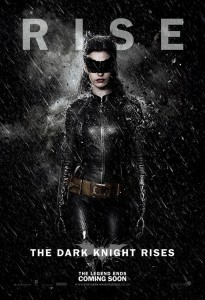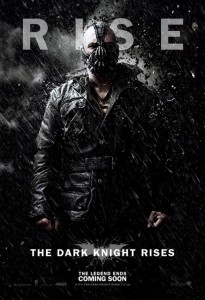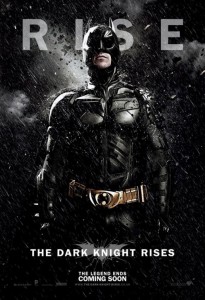Note: While I consider this a generally spoiler-free review, I have **marked** a two-paragraph section that the particularly sensitive might want to avoid, as they tread a little closer to specifics.
It is not long into the The Dark Knight Rises that it become clear just how much the structural and thematic bravery of The Dark Knight backed Nolan and company into a corner when trying to follow it up. That film, which managed the sublime trick of weaving timely fears into a comic book-as-mythology tale, did not treat its characters as franchise pawns, but instead wove into them the deepest thematic concerns of its hero before burning many of them to the ground. What we were left with was Batman as enduring symbol, Joker as immortal foe prophetically declaring that the two are “destined to do this forever,” alluding to the episodic swinging of the pendulum from chaos to order that each battle between Batman and his rogue’s gallery will represent forevermore. In this moment Nolan showed us these characters as mirrors that, when properly aligned with one swinging and cackling and the other horrified and righteous and angry but unable to let him fall, reveal their recursive relationship extending into infinity. The kind of infinity from which you can write a hundreds years worth of comic stories.
Unfortunately, that infinity does not lend itself to franchise cinema.
By taking on the comic book hero as legend, Nolan was able to craft a pair of films that transcend their flaws and stand firmly as great, but they did not want for a third. The Dark Knight ends with the perfect ellipses for our collective imagination to pick up and fill with comic stories or series plots, yet Nolan’s first move with The Dark Knight Rises is to turn that ellipses into a period. The only thing as epic as the beginning of a story is the end, and forced to find another mythic story to tell, Nolan has decided to “skip to the end” so to speak, and find out what draws his Batman’s story to a close. What is outright shocking is that Nolan is perfectly willing to toss his previous Batman film under the bus, reject its ideas, and reveal his dissatisfaction with the idea of The Dark Knight as a quietly righteous scapegoat, preserving the city’s soul by virtue of thick skin. The result is that though The Dark Knight Rises is never as viscerally satisfying or exciting as the mythologically structured The Dark Knight, goddamn if it’s not bold and exhilarating.
Still, it’s almost shocking with what immediacy the triumphant tone of the previous film is stomped out as we see a conflicted Commissioner Gordon struggle with the enduring messianic image of Harvey Dent, and watch a crutch-leaning Bruce Wayne playing hermit eight years after the events of The Dark Knight. The suggestion is that the city largely righted itself after that fateful night, the balance not the result of the continuing work of a silent guardian or watchful protector, but of legislation enacted in Harvey Dent’s name that effectively unwound the mob. It’s a strange choice that not only turns Bruce Wayne into a profound mope, but it also retroactively steals the thunder from the triumph of the Bat-pod speeding off into the light when you know it drove right into the garage to be parked for nearly a decade. In fact, it turns out most of the remaining characters and institutions from the previous film are either inert or in outright shambles, from Bruce’s health to his corporation- even a character that is still thriving and active is quickly put on the bench by the early machinations of the plot.
These choices make for an odd tone with which to open a trilogy-capper, but the film is not without immediate energy as it takes great care to introduce its new characters with force. Tom Hardy’s Bane is a menacing Ox of a man whose frightening countenance and remorseless eyes strike quite the contrast to his voice’s weezing, professorial timbre. As he did with the Joker, Nolan treats Bane as a force, a manifestation of opposing will not just to Batman, but to Gotham itself. Bane is most often expressing himself though clearly disingenuous political theatre — which robs him of some of the legendary heft the Joker attained as an anarchic Plato — but when speaking in grander terms, he is every bit the frightening Villain with a capital V, and he’s a blast to watch. As a foil to Batman he mostly represents an unstoppable brute force ready to pound Wayne into the depths, but the Nolans write him with enough Bondian masterminding that he represents a clear intellectual foe as well.
Taking the franchise to its most comic book-feeling places is Selina Kyle, and though never given an eponymous “I’m Catwoman” moment, the straightforward costuming and Hathaway’s gleeful performance feel unprecedented for the franchise. The Scarecrow, Joker, and Two-Face are all more obviously fantastical presences in the “Nolanverse,” yet something about Kyle’s Catsuit feels the most transplanted from the page or ‘toon. She’s not an unwelcome sight, nor is the sharp-edged femininity of Marion Cotillard as Miranda Tate. It would take a fool to not suspect her character of having a hidden layer, but without overtly spoiling the unexpected role she plays in the film’s most important sequences, suffice to say she handles it all like a pro.
Joseph Gordon Levitt’s John Blake is also a welcome addition to the fold, with Levitt carefully unspooling a performance that dances between being damaged and naive. He’s the super-arch “rookie” that becomes Commissioner Gordon’s most important arm when the shadowy shit hits Gotham’s fan, and he perfectly accentuates or enhances the energy of every scene of which he is a part.
Meanwhile, Cain and Oldman are doing their same reliable work here, though both are given at least one big moment to stretch their characters a bit when the strain really hits and the cracks show. For Cain this is heartbreakingly communicating fears harbored over decades, while with Oldman we see a bit of manic anger peek through his usual austere civility.
 This brings us to Batman himself, Christian Bale, who doesn’t find much to do with the mopier, Howard Hughesian side of Bruce Wayne we’re first stuck with, but delicately weaves the weariness in with the subtle humor and angry strength of Batman as he, you know… rises and stuff. Bale even achieves some better handle on the raspy whisperyell he employs from under the cowl.
This brings us to Batman himself, Christian Bale, who doesn’t find much to do with the mopier, Howard Hughesian side of Bruce Wayne we’re first stuck with, but delicately weaves the weariness in with the subtle humor and angry strength of Batman as he, you know… rises and stuff. Bale even achieves some better handle on the raspy whisperyell he employs from under the cowl.
All these players, new and old, are woven into a story that slowly works to narrow Batman’s story while simultaneously upping the stakes for Gotham. Though The Dark Knight Rises meets a challenge trying to build on the mythology of its predecessor, there’s no doubt the scale is ratcheted up significantly. Having previously dispensed with MacGuffins and singular threats in exchange for wide-scale chaos and ideological calamity, Nolan takes it back to the Big Fucking Machine With A Countdown To BOOM™, in just one of the many ways the third films circles back around to the first. So while the literal ticking clock is rather typical, by mining the Knightfall comic arc and the unprecedented resources of WB, Nolan manages to up the scale of the calamity around said device to a very atypical level. Though Nolan still doesn’t have a perfect handle on selling a populated metropolis –much less one assaulted by society-upending revolutionaries– The Siege of Gotham that Bane orchestrates is undeniably ballsy.
The publicly cited influence on the Nolan Bro’s here is a Tale of Two Cities, which is both a boon and a… burden on the film. The classic story of the French Revolution provides a refreshingly bold frame of reference for a blockbuster movie, and the mythic quality it lends this conclusive film is appropriate. It’s also a timely story with its examination of class dynamics and the irrevocable shifting of a wealthy society from a paradigm of complacency into an unclear future. The problem is that since the script was written, our politics and culture have only grown more complex, and the fact of the matter is The Dark Knight Rises features some pretty sloppy, troubling subtext that contrasts sharply with the prescient themes of The Dark Knight.
One of the greatest triumphs of the second Batman film is the shocking subtlety with which Nolan integrated imagery as specific as wiretapping surveillance, camcorder terrorist messages, and 9/11-like destruction into a comic book movie. By making the Joker the manifestation not of terrorist ideology, but of our fear of terrorist acts, it allowed Batman to be a “lesser of two evils” figure struggling with what lines to cross to fight such terror. And while our hero may have made some mistakes that ring awfully like some Bush-era controversies in the course of the story, the ultimate conclusions of the film and our hero draw back on the good side of freedom and courage. In The Dark Knight Rises the engaged political subtext lacks such precision, and while it effectively imbues the movie with a general aura of the times, its imagery is far messier.
**As Bane’s plan unfolds, there is never any doubt that leveling Gotham is the ultimate goal, and yet Bane uses the spirit of a populist revolt to take over the city. What we really see is Bane explicitly threaten the normal folks of Gotham with destruction after murdering two football teams, and then his (very) vaguely Socialist manifesto delivered in front of a prison full of criminals freed, not by the population he’s inciting to rise up, but by his own army. Nolan’s imprecise handling of the “revolution,” such as it is, makes it unclear to what degree the general population of Gotham participates in the following assault, abduction, and punishment of Gotham’s bourgeois, though it’s definitely clear that at least some of the Gotham’s citizenry are taking the opportunity to eat the rich. Nolan is backed into a corner here as Batman essentially becomes a force to put “the people” back in their place, with traditional agents of authority –like the police– backing him as an army. This all clumsily (with unintentional specificity) evokes the Occupy movement and the nastiest, most recent class-warfare rants of talk show pundits without really drawing any conclusions. As the heroism begins and the film works towards a climax, the focus shifts to a theme of the everyman doing whatever good he can, leaving the messier political stuff behind unresolved.
Also, in terms of leaving narrative strands behind, it at this point must be suggested that Nolan is decidedly and deliberately unwilling to provide dramatic conclusions for his villains. While the big J was treated with the aforementioned vague ending, most of Nolan’s other villains have gone out with whimpers rather than bangs, a trend that, in some cases, continues here. While previously attributable to laziness or rushed screenwriting, one must now contemplate if Nolan thoughtfully appreciates the idea of the unceremonious defeat, the deflation of villainous majesty the moment the plug is pulled…**
Dipping into the shallower end of the pond, the action spectacle is different in The Dark Knight Rises than Nolan’s other Batman films, in that it largely leaves behind big splash-page-worthy moments of iconography and opts for a general escalation of scale. Everything is bigger and there’s more of it, and the thrilling moments come from the little things like the number of police cars chasing our hero or a cool 90º Bat-pod turn. You won’t find a loin-clinching moment quite like an 18-wheeler going end-over-end, but the film does not lack for spectacle. Nolan’s action chops have only tightened, which also serves to increase the mileage of the more general exciting moments. Fight scenes have a little more clarity and pep to them, though Nolan should be credited for finding a rather punishing, brutal manner with which to shoot the only fight that really matters…
Visually the film is spectacular, if restrained. The film takes places primarily in snowy daylight, which is a wonderful choice and nicely plays into both Bane’s theft of the shadows from our hero, so to speak, as well as the temporal distance from the previous films. Nolan and Pfister’s work with both 35 and 70mm is gorgeous, even if a careful eye will reveal that Nolan does not often mention the precipitous drop in the tightness of focus pulling on the grander format. One can frequently spot the soft faces / sharp ears that come with the ultra-shallow depth of field of IMAX lenses, but it’s a worthwhile sacrifice to the epic clarity of most of the footage. The shift between the two formats is natural and easy, though the occasional 35mm shot suffers for being sandwiched between the hyper-quality of IMAX. These are likely concerns for only the smallest section of viewers, but there you have it.
 Both the sound design and the score do a fabulous job of integrating new, unique textures with familiar cues and motifs, though none of it immediately catches the ear and dials into the psyche the way some of the work of the previous film manages. It’s appreciable on much the same level as Nolan’s avoidance of CGI and reliance on practically-staged spectacle. It subtly imbues the film with a more timeless feel, and the CGI that does pop up is, of course, of the highest caliber and likely to age as well as any.
Both the sound design and the score do a fabulous job of integrating new, unique textures with familiar cues and motifs, though none of it immediately catches the ear and dials into the psyche the way some of the work of the previous film manages. It’s appreciable on much the same level as Nolan’s avoidance of CGI and reliance on practically-staged spectacle. It subtly imbues the film with a more timeless feel, and the CGI that does pop up is, of course, of the highest caliber and likely to age as well as any.
It is that The Dark Knight Rises is the entry in Nolan’s franchise that is most reliant on the other movies that invites such systematic comparisons to its predecessor. While both Batman Begins and The Dark Knight can easily stand alone while accentuating each other, The Dark Knight Rises inherently leans on what came before as shakily as Hermit Wayne leans on his crutch. This third film does pay off Begins in satisfying ways, and again, Nolan shows bravery by tearing down the rickety scheme around which he based his hero’s earlier entrance into the mythological. But in exchange for creating a more permanent, celebrated legacy for his hero, Nolan has sunk the franchise’s feet into thicker political mud and messier storytelling that certainly unwinds the relative tightness that came before, and has ended things with a film that does not stand on its own. At the end of the day though, the real victory is that the final moments are delicately orchestrated and put a satisfactory punctuation mark on a seven year journey with the finale the franchise deserves, but doesn’t need.
Rating: 




Out of a Possible 5 Stars
